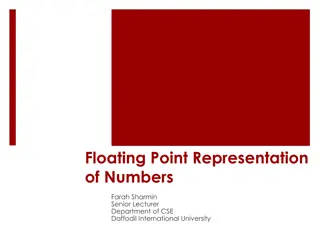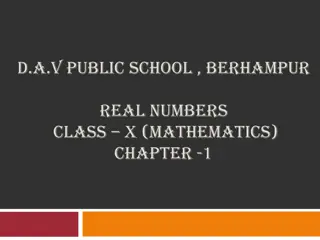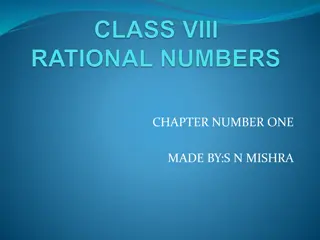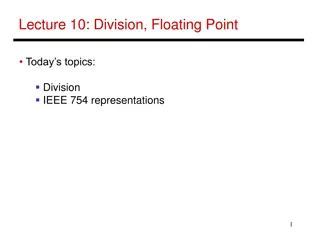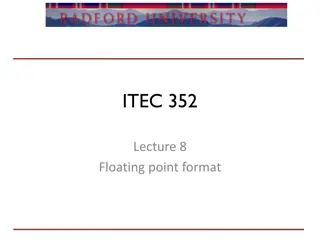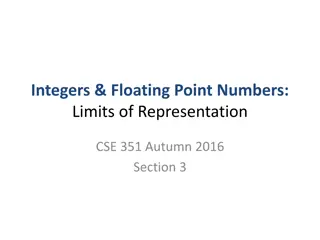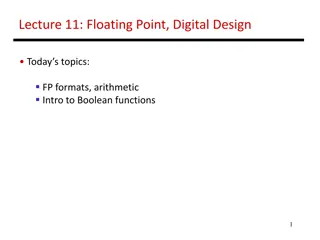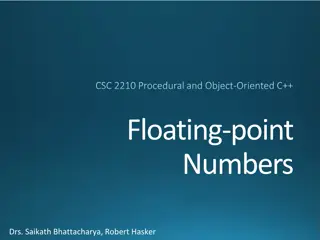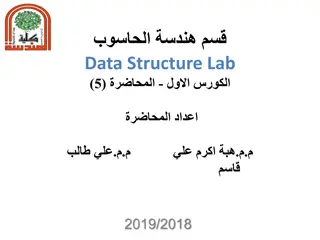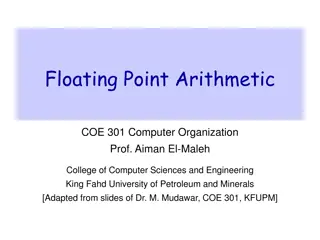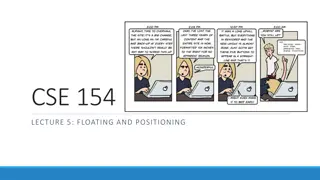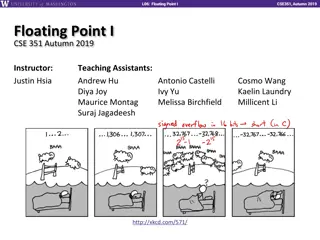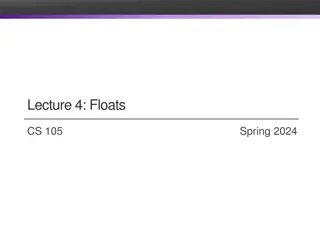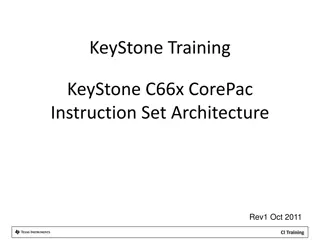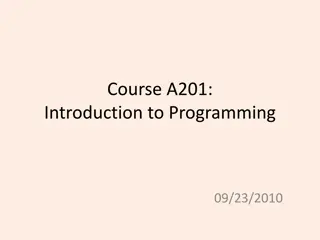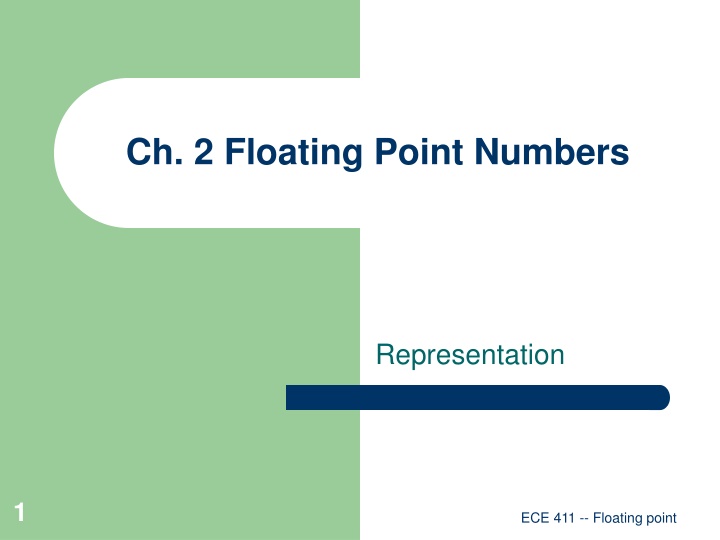
Floating Point Numbers Representation in ECE 411
Explore the binary representation of fractional numbers, conversions between decimal and binary, the IEEE 754 standard, pitfalls of finite digits, and the features of IEEE 754 format for floating point numbers. Dive into scientific notation, fixed-size representations, and more in ECE 411.
Download Presentation

Please find below an Image/Link to download the presentation.
The content on the website is provided AS IS for your information and personal use only. It may not be sold, licensed, or shared on other websites without obtaining consent from the author. If you encounter any issues during the download, it is possible that the publisher has removed the file from their server.
You are allowed to download the files provided on this website for personal or commercial use, subject to the condition that they are used lawfully. All files are the property of their respective owners.
The content on the website is provided AS IS for your information and personal use only. It may not be sold, licensed, or shared on other websites without obtaining consent from the author.
E N D
Presentation Transcript
Ch. 2 Floating Point Numbers Representation 1 ECE 411 -- Floating point
Floating point numbers Binary representation of fractional numbers IEEE 754 standard 2 ECE 411 -- Floating point
Binary Decimal conversion 23.47 = 2 101 + 3 100 + 4 10-1 + 7 10-2 decimal point 10.01two = 1 21 + 0 20 + 0 2-1 + 1 2-2 binary point = 1 2 + 0 1 + 0 + 1 = 2 + 0.25 = 2.25 3 ECE 411 -- Floating point
Decimal Binary conversion Write number as sum of powers of 2 0.8125 = 0.5 + 0.25 + 0.0625 = 2-1 + 2-2 + 2-4 = 0.1101two Algorithm: Repeatedly multiply fraction by two until fraction becomes zero. 0.8125 1.625 0.625 1.25 0.25 0.5 0.5 1.0 4 ECE 411 -- Floating point
Beware Finite decimal digits finite binary digits Example: 0.1ten 0.2 0.4 0.8 1.6 1.2 0.4 0.8 1.6 1.2 0.4 0.1ten = 0.00011001100110011 two = 0.00011two (infinite repeating binary) The more bits, the binary rep gets closer to 0.1ten 5 ECE 411 -- Floating point
Scientific notation Decimal: -123,000,000,000,000 -1.23 1014 0.000 000 000 000 000 123 +1.23 10-16 Binary: 110 1100 0000 0000 1.1011 214 -0.0000 0000 0000 0001 1011 -1.1101 2-16 6 ECE 411 -- Floating point
Floating point representation Three pieces: sign exponent significand Format: sign exponent significand Fixed-size representation (32-bit, 64-bit) 1 sign bit more exponent bits greater range more significand bits greater accuracy 7 ECE 411 -- Floating point
IEEE 754 floating point standards Single precision (32-bit) format 1 8 23 S E F Normalized rule: number represented is (-1)S 1.F 2E-127, E ( 00 0 or 11 1) Example: +101101.101 +1.01101101 25 0 1000 0100 0110 1101 0000 0000 0000 000 8 ECE 411 -- Floating point
Features of IEEE 754 format Sign: 1 negative, 0 non-negative Significand: Normalized number: always a 1 left of binary point (except when E is 0 or 255) Do not waste a bit on this 1 "hidden 1" Exponent: Not two's-complement representation Unsigned interpretation minus bias 9 ECE 411 -- Floating point
Example: 0.75 0.75 ten = 0.11two = 1.1 x 2 -1 1.1 = 1. F F = 1 E 127 = -1 E = 127 -1 = 126 = 01111110two S = 0 00111111010000000000000000000000 = 0x3F400000 10 ECE 411 -- Floating point
Example 0.1ten - Check float.a 0.1ten = 0.00011two = 1.10011two x 2 -4 = 1.F x 2 E-127 F =10011 -4 = E 127 E = 127 -4 = 123 = 01111011two 00111101110011001100110011001100110011 0x3DCCCCCD, why D at the least signif digit? 11 ECE 411 -- Floating point
IEEE Double precision standard 1 11 52 S E F E not 00 0 (decimal 0) or 11 1(decimal 2047) Normalized rule: number represented is (-1)S 1.F 2E-1023 12 ECE 411 -- Floating point
Special-case numbers Problem: hidden 1 prevents representation of 0 Solution: make exceptions to the rule Bit patterns reserved for unusual numbers: E = 00 0 E = 11 1 13 ECE 411 -- Floating point
Special-case numbers Zeroes: +0 -0 0 00 0 00 0 1 00 0 00 0 Infinities: + - 0 11 1 00 0 1 11 1 00 0 14 ECE 411 -- Floating point
Denormalized numbers No hidden 1 Allows numbers very close to 0 E = 00 0 Different interpretation applies Denormalization rule: number represented is (-1)S 0.F 2-126 (single-precision) (-1)S 0.F 2-1022 (double-precision) Note: zeroes follow this rule Not a Number (NaN): E = 11 1; F != 00 0 15 ECE 411 -- Floating point
IEEE 754 summary E = 00 0, F = 00 0 0 E = 00 0, F 00 0 denormalized 00 00 < E < 11 1 normalized E = 11 1 F = 00 0 infinities F 00 0 NaN 16 ECE 411 -- Floating point

